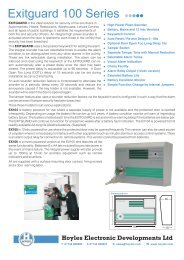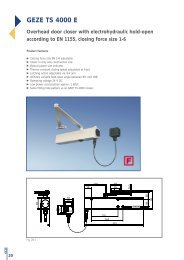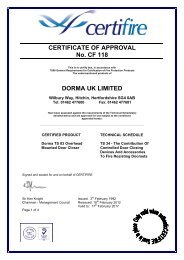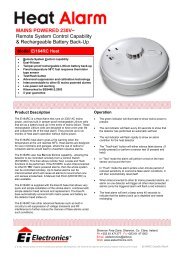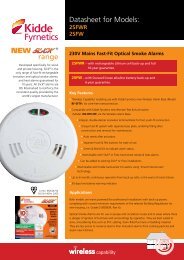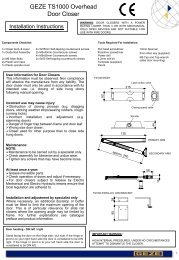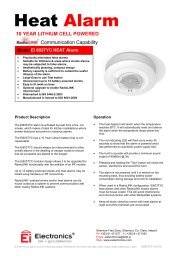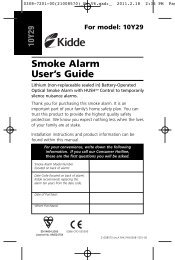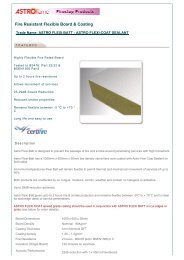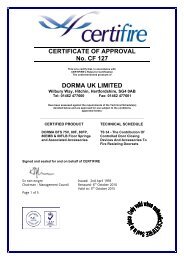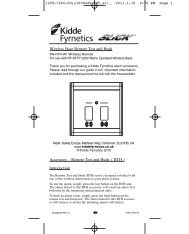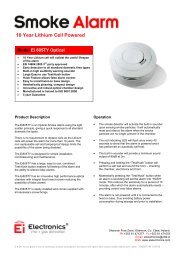Kidde Firex Smoke Alarm Manual
Kidde Firex Smoke Alarm Manual
Kidde Firex Smoke Alarm Manual
You also want an ePaper? Increase the reach of your titles
YUMPU automatically turns print PDFs into web optimized ePapers that Google loves.
1374-7201-01(110-1195)_EN_V4:_ 2010.1.29 9:26 AM Page 1<br />
USER’S MANUAL<br />
4870(MODEL I240C)<br />
4881(MODEL IAR230C)<br />
Ionisation<br />
4973(MODEL PADC240)<br />
4985(MODEL PAR230)<br />
Optical<br />
EN: 14604:2005<br />
LICENSE NO. KM 524754<br />
0086-CPD-535595<br />
PLEASE READ AND SAVE<br />
INSTALLER: Please leave this manual with the product.<br />
Model 4870<br />
Model 4881<br />
Model 4973<br />
Model 4985<br />
SMOKE ALARM DESCRIPTION<br />
Ionisation 230V AC smoke alarm with 9V<br />
battery back-up and Hush Button<br />
Ionisation 230V AC smoke alarm with rechargeable<br />
battery backup and Hush Button<br />
Optical 230V AC smoke alarm with 9V<br />
battery back-up with Hush Buttonl<br />
Optical 230V AC smoke alarm with rechargeable<br />
battery back-up and Hush Button<br />
SMOKE ALARM FEATURES<br />
• Interconnects with up to 24 Model 4870, 4973, 4881, 4985 smoke alarms and<br />
<strong>Kidde</strong> 123/9hi, 123/9hill, 223/9hi, 223/0hill, 323/9hi & 323/9hill alarms. Unique<br />
power connector prevents interconnection with incompatible smoke alarms or<br />
security systems.<br />
• Tamper-resist bracket quickly snaps into place and serves as a safeguard<br />
against tampering.<br />
• Multi-purpose green and red LEDs indicate that the smoke alarm is receiving<br />
AC power, working under normal operation, in alarm, or under Hush Button.<br />
• Loud alarm horn—85 decibels at 3 metres (10 feet)—sounds to alert you of<br />
an emergency.<br />
• Test button checks smoke alarm operation.<br />
• Models 4870, 4973 , 4985 and 4881 feature Hush Button, which, when<br />
activated, quiets unwanted alarms for up to 15 minutes.<br />
• Models 4870 and 4973 will not attach to the mounting bracket if a<br />
battery is not in the battery pocket. These models will also sound a short<br />
beep about once a minute if the battery is weak or improperly connected.<br />
• Models 4881 and 4985 include permanent rechargeable lithium<br />
batteries.<br />
!<br />
IMPORTANT SAFETY INFORMATION<br />
PLEASE READ AND SAVE THESE<br />
INSTRUCTIONS<br />
W A R N I N G<br />
• DO NOT paint or cover the smoke alarm with tape.<br />
• This smoke alarm should be out of the reach of children.<br />
• AC smoke alarms require constant 230V AC, 50Hz power to operate<br />
properly. Mains-powered smoke alarms WILL NOT work if AC power is not<br />
connected or has failed or been interrupted for any reason. Models 4870 and<br />
4973 require a working 9-volt battery to operate properly in the event of a<br />
power failure. Models 4881 and 4985 require a minimum of 2 full days under<br />
mains power to reach full backup capacity. DO NOT use any other kind of<br />
battery except as specified in this manual. DO NOT connect this smoke<br />
alarm to any other type of smoke alarm or auxiliary device, except those<br />
listed in this manual.<br />
• DO NOT remove or disconnect battery or turn off AC power to quiet<br />
unwanted alarms. This will remove your protection. Open windows or fan the air<br />
around smoke alarm to silence it. Models , 4870, 4881, 4985 and 4973 smoke<br />
alarms feature a Hush Button which, when activated, will quiet unwanted alarms<br />
for up to 15 minutes.<br />
• The Push-to-Test button accurately tests all smoke alarm functions.<br />
DO NOT use any other test method. Test smoke alarm weekly to<br />
ensure proper operation.<br />
• This smoke alarm should be installed only by a qualified<br />
electrician.<br />
• This smoke alarm is designed to be used inside a single family<br />
household only. In multi-family buildings, each individual living unit<br />
should have its own smoke alarms. Do not install in non-residential<br />
buildings or places which house many people like hotels, motels,<br />
dormitories, hospitals, nursing homes, or group homes of any kind. This<br />
smoke alarm is not a substitute for a complete alarm system.<br />
1
1374-7201-01(110-1195)_EN_V4:_ 2010.1.29 9:26 AM Page 2<br />
• Install a smoke alarm in every room and on every level of the home.<br />
<strong>Smoke</strong> may not reach the smoke alarm for many reasons. For example,<br />
if a fire starts in a remote part of the home, on another level, in a chimney,<br />
wall, roof, or on the other side of a closed door, smoke may not<br />
reach the smoke alarm in time to alert household members. A smoke<br />
alarm will not promptly detect a fire EXCEPT in the area or room in<br />
which it is installed.<br />
• Interconnected smoke alarms installed in every room and on every<br />
level of the household offers maximum protection. We recommend<br />
interconnecting smoke alarms so that when one smoke alarm senses<br />
smoke and sounds its alarm, all others will sound as well. Do not<br />
interconnect smoke alarms from one individual family living unit to<br />
another. Do not connect this smoke alarm to any other type of alarm or<br />
auxiliary device.<br />
• <strong>Smoke</strong> alarms may not alert every household member every time.<br />
The alarm horn is loud in order to alert individuals of a potential<br />
danger. However, there may be limiting circumstances where a<br />
household member may not hear the alarm (i.e. outdoor or indoor<br />
noise, sound sleepers, drug or alcohol usage, the hearing impaired,<br />
etc.). If you suspect that this smoke alarm may not alert a household<br />
member, install and maintain specialty smoke alarms. Household<br />
members must hear the alarm’s warning sound and quickly respond to<br />
it to reduce the risk of damage, injury, or death that may result from<br />
fire. If a household member is hearing impaired, install special smoke<br />
alarms with lights or vibrating devices to alert occupants.<br />
• <strong>Smoke</strong> alarms can only sound their alarms when they detect<br />
smoke. <strong>Smoke</strong> alarms detect combustion particles in the air. They do<br />
not sense heat, flame, or gas. This smoke alarm is designed to give<br />
audible warning of a developing fire. However, many fires are<br />
fast-burning, explosive, or intentional. Others are caused by<br />
carelessness or safety hazards. <strong>Smoke</strong> may not reach the smoke<br />
alarm QUICKLY ENOUGH to ensure safe escape.<br />
• <strong>Smoke</strong> alarms have limitations. This smoke alarm is not fool-proof<br />
and is not warranted to protect lives or property from fire. <strong>Smoke</strong><br />
alarms are not a substitute for insurance. Homeowners and renters<br />
should insure their lives and property. In addition, it is possible for the<br />
smoke alarm to fail at any time. For this reason, you must test the<br />
smoke alarm weekly and replace every 10 years.<br />
SMOKE ALARM PLACEMENT<br />
It is recommended to achieve complete coverage protection by installing<br />
a smoke alarm in every room of your home.<br />
At a minimum, smoke alarms shall be installed outside or inside all bedrooms<br />
and on each additional storey of the family living unit including<br />
basements, and converted loft spaces. Any home requires a minimum of<br />
two smoke alarms.<br />
Typical Single Storey Home<br />
• Install a smoke alarm on the ceiling or wall inside each bedroom and<br />
in the hallway outside each separate sleeping area. If a bedroom area<br />
hallway is more than 9 m long, install a smoke alarm at each end.<br />
DINING ROOM KITCHEN BEDROOM BEDROOM<br />
Typical Two-Storey Home<br />
• Install a smoke alarm on the ceiling<br />
inside each bedroom and in the hallway<br />
outside each separate sleeping<br />
area.<br />
If a bedroom area hallway is more than<br />
9 m long, install a smoke alarm at each<br />
end.<br />
• Install a smoke alarm at the top and<br />
bottom of a first-to-second floor stairwell.<br />
LIVING ROOM<br />
FAMILY ROOM<br />
FIREPLACE<br />
BEDROOM<br />
KITCHEN<br />
DINING<br />
ROOM<br />
BEDROOM<br />
BEDROOM<br />
BEDROOM<br />
ATTIC OFFICE<br />
BEDROOM<br />
BEDROOM<br />
LIVING ROOM<br />
KITCHEN<br />
GARAGE<br />
Key<br />
Ionisation <strong>Alarm</strong><br />
Optical <strong>Alarm</strong>s<br />
Heat <strong>Alarm</strong><br />
2
1374-7201-01(110-1195)_EN_V4:_ 2010.1.29 9:26 AM Page 3<br />
IMPORTANT SMOKE ALARM PLACEMENT AND<br />
EXCEPTION INFORMATION:<br />
• Install a smoke alarm as close to the centre<br />
10cm<br />
CEILING<br />
of the ceiling as possible. If this is not<br />
practical, mount no closer than 10 cm (4<br />
ACCEPTABLE HERE<br />
10cm<br />
MINIMUM<br />
inches) from a wall or corner. Also, if local<br />
NEVER HERE<br />
30cm<br />
codes allow, install smoke alarms on walls,<br />
MAXIMUM<br />
TOP OF DETECTOR<br />
between 10 and 30 cm (4 and 12 inches)<br />
ACCEPTABLE HERE<br />
from ceiling/wall intersections.<br />
SIDE<br />
WALL<br />
• Install a minimum of two smoke alarms in<br />
every home, no matter how small the<br />
home. Any size home requires fitting a<br />
minimum of two smoke alarms.<br />
SOFFIT 20cm<br />
• Install a smoke alarm in each room that is<br />
divided by a partial wall (either coming<br />
STUB WALL<br />
down from the ceiling at least 20 cm (8<br />
inches), or coming up from the floor).<br />
• Install smoke alarms on peaked, cathedral,<br />
or gabled ceilings 1 m from the highest<br />
1M<br />
PEAKED CEILING<br />
point (measured horizontally).<br />
• Install a smoke alarm in lived-in attics or<br />
attics which house electrical equipment like<br />
furnaces, air conditioners, or heaters.<br />
Locations to be Avoided (<strong>Smoke</strong> <strong>Alarm</strong>s)<br />
• Do not site within 3m of a steam source e.g. kitchen/bath room or<br />
garage.<br />
• Do not site within 1m of dimmer control cabling or cable alarm into<br />
any such cobling.<br />
• Do not site adjacent to any heat source.<br />
• Do not site within 300m (12”) of any lights fixure and 300mm from<br />
any wall.<br />
• Do not site near fluorescent lights; electronic noise may cause<br />
nuisance alarms.<br />
• In locations where temperature may fall below 5°C (41°F), or above<br />
40°C (104°F).<br />
• In very dusty/dirty/insect laden areas.<br />
• Any location where the free flow of smoke to the alarm could be<br />
interrupted (e.g. next/above a door/air vent/heater/air-con unit).<br />
• Areas where routine maintenance or operating hush/test button is<br />
difficult (e.g. top of stairwells).<br />
• Siting should be in accordance with the current Building Regulations<br />
and/or BS5839 Pt6/current I.E.E. Regulations.<br />
CAUTION: <strong>Alarm</strong> should not be exposed to dripping or splashing.<br />
HOW TO INSTALL<br />
THIS SMOKE ALARM<br />
! DANGER: ELECTRICAL SHOCK HAZARD. Turn off<br />
power at the main consumer unit or circuit<br />
breaker by removing the fuse or<br />
switching the circuit breaker to the OFF<br />
position and securing it.<br />
! WARNING: Mains operated smoke alarms should be<br />
installed by a qualified electrician in<br />
accordance with the Regulations for<br />
Electrical Installations published by the<br />
Institution of Electrical Engineers (BS).<br />
Failure to install this smoke alarm correctly<br />
may expose the user to shock or<br />
fire hazards.<br />
! WARNING: The smoke alarm, its associated supply<br />
and interconnect wiring must be installed<br />
in accordance with BS 7671 published by<br />
the Institution of Electrical Engineers.<br />
! WARNING: If a <strong>Firex</strong> Rechargeable alarm is replacing<br />
an earlier non rechargeable model, the<br />
new cable harness with 4 strands must<br />
be used. Using the old 3 strand harness<br />
will not allow new rechargeable alarm to<br />
charge it's batteries.<br />
• Install smoke alarm on ceiling, standard electrical box, or surface<br />
mounting pattress.<br />
1. Align mounting plate with mounting holes of standard electrical box<br />
or surface mounting pattress. For siting on ceiling, use mounting<br />
plate as template to mark holes. Drill holes and insert supplied<br />
screw plugs into holes until flush with ceiling.Ceiling mounting is<br />
always preferable over wall mounting.<br />
2. Secure mounting plate to electrical box, pattress or ceiling.<br />
(Diagram illustrates fixing mounting plate to electrical box.)<br />
3. Connect blue cable from connector plug of smoke alarm to neutral<br />
(black or blue) mains power cable.<br />
3
1374-7201-01(110-1195)_EN_V4:_ 2010.1.29 9:26 AM Page 4<br />
4. Connect brown cable from connector plug of smoke alarm to live (red<br />
or brown) mains power cable .<br />
5. If interconnection is desired, connect orange or white cable from connector<br />
to interconnect strand on the 3 core & earth cable. See section,<br />
“Interconnecting <strong>Smoke</strong> <strong>Alarm</strong>s.”<br />
NOTE: If this will be a single-station smoke alarm, cover orange or white<br />
cable with electrical tape and tuck into pattress.<br />
DRY LINING BOX OR PATTRESS<br />
DRY LINING BOX OR PATTRESS<br />
CEILING<br />
CEILING<br />
BROWN LINE<br />
ORANGE OR WHITE INTERLINK<br />
BLUE<br />
NEUTRAL<br />
BROWN LINE<br />
BLUE NEUTRAL<br />
ORANGE OR WHITE<br />
INTERLINK<br />
BLUE<br />
MODELS 4870, 4973<br />
MODELS 4985, 4881(Rechargeable)<br />
Steps 6-9 for Models 4870 and 4973 ONLY:<br />
6. Lift open battery pocket door.<br />
7. Connect new 9-volt battery to battery connector inside battery pocket. BE<br />
SURE BATTERY IS SECURELY CONNECTED. <strong>Smoke</strong> alarm may beep<br />
briefly when battery is installed.<br />
8. Close battery pocket door, snapping it into place.<br />
9. Push button and hold button on front cover of smoke alarm for three<br />
(3) seconds. <strong>Smoke</strong> alarm should sound its alarm horn if battery is fitted<br />
correctly.<br />
10. Attach connector plug to pins on back of smoke alarm. Plug will only<br />
fit one way and will snap into place.<br />
11. Gently tug connector to be sure it is attached securely.<br />
12. Position smoke alarm to mounting plate so that keyslot on side of<br />
smoke alarm is to left of tab on mounting plate. Turn clockwise to lock<br />
into place.<br />
NOTE: (For Models 4870 and 4973 only):<br />
<strong>Smoke</strong> alarm will not mount to plate if battery is not installed.<br />
13. Turn on power at main fuse box or circuit breaker. The green LED on the<br />
cover should be illuminated.<br />
14. Test smoke alarm. See “TESTING THE SMOKE ALARM”.<br />
INTERCONNECTING<br />
SMOKE ALARMS<br />
• Use 1.5mm 2 minimum solid or stranded cable with a rating of 230V.<br />
When interconnecting, maximum cable length between any two is 450<br />
m for 1.5mm 2 or 1200 m for 2.5mm 2 (20 OHMS loop resistance).<br />
• This smoke alarm may be interconnected with as many as 23other<br />
Models 4870, 4973, 4881, and 4985 smoke alarms. DO NOT connect to<br />
any other type or model smoke alarm.<br />
• Connect smoke alarms to a single circuit. Wiring must conform to IEE<br />
Regulations for electrical installation.<br />
ORANGE OR WHITE<br />
ORANGE OR WHITE<br />
BLACK OR BLUE<br />
RED OR BROWN<br />
NEUTRAL<br />
LINE<br />
FOR INTERCONNECT: USE STANDARD 3 core & earth cable 1.5mm2 cable<br />
RED AND GREEN LED<br />
INDICATORS<br />
This smoke alarm features red and green LED indicators that can be seen<br />
through the Push-to-Test button or the LED lens above the test button.<br />
The LEDs indicate the following:<br />
GREEN LED<br />
ON — AC power is present.<br />
OFF — AC power is not present.<br />
RED LED<br />
Blinks once a minute<br />
Blinks once a second<br />
— indicating normal operation.<br />
— smoke alarm senses smoke and simultaneously<br />
sounds an audible alarm.<br />
Blinks once every 10 seconds — smoke alarm is quieting an unwanted<br />
alarm. (Models 4870, 4973, and 4881,<br />
4985.)<br />
(Interconnected system only):<br />
4
1374-7201-01(110-1195)_EN_V4:_ 2010.1.29 9:26 AM Page 5<br />
OFF — another smoke alarm in the network has sensed<br />
smoke and is signalling this alarm.<br />
HUSH BUTTON<br />
Models 4870, 4973, 4985 and 4881 feature Hush Button that, when activated,<br />
quiets unwanted alarms for up to 15 minutes.<br />
To use the Hush Button:<br />
Press and release the test button during an unwanted alarm. The alarm<br />
should stop within ten seconds. This means the smoke alarm is in Hush<br />
Button. If the smoke alarm does not go into Hush Button and continues to<br />
sound its loud alarm horn, or if it initially goes into Hush Button then<br />
resounds the alarm, the smoke is too heavy and could be a dangerous<br />
situation – take emergency action.<br />
TESTING THE SMOKE ALARM<br />
!<br />
W A R N I N G<br />
• Test each smoke alarm to be sure it is installed correctly and operating<br />
properly.<br />
• Test all smoke alarms in an interconnected system after installation.<br />
• The Push-to-Test button accurately tests all functions. DO NOT use an<br />
open flame to test this smoke alarm. You may ignite and damage the<br />
smoke alarm or your home.<br />
• Test smoke alarms weekly and upon returning from holiday or when no<br />
one has been in the household for several days.<br />
• Stand at arm’s length from the smoke alarm when testing. The alarm<br />
horn is loud to alert you to an emergency and can be harmful to hearing.<br />
Test all smoke alarms weekly by doing the following:<br />
1. Check Push-to-Test button. A constant green light indicates the smoke<br />
alarm is receiving 230V AC, 50Hz power. A red flashing LED about once<br />
a minute verifies operation. For models 4870, 4973, 4881, and 4985 the<br />
red flashing LED also verifies that a working battery is present.<br />
2. Firmly depress the Push-to-Test button for at least five (5) seconds. The<br />
smoke alarm will sound a loud beep about four (4) times a second. The<br />
alarm may sound for up to 10 seconds after releasing the Push-to-Test<br />
button.<br />
NOTE: If smoke alarms are interconnected, all smoke alarms should<br />
sound an alarm within three seconds after any test button is<br />
pushed and the tested smoke alarm sounds.<br />
3. If smoke alarm does not sound, turn off power at main fuse box or<br />
circuit breaker and check wiring. Retest smoke alarm.<br />
!<br />
DANGER: If alarm horn sounds, and smoke alarm is<br />
not being tested, the smoke alarm is sensing<br />
smoke. THE SOUND OF THE ALARM HORN<br />
REQUIRES YOUR IMMEDIATE ATTENTION<br />
AND ACTION.<br />
MAINTENANCE AND CLEANING<br />
In addition to weekly testing, Models 4870 and 4973 also require periodic battery<br />
replacement. Regularly clean smoke alarm to remove dust, dirt, and<br />
debris.<br />
!<br />
!<br />
!<br />
WARNING: <strong>Alarm</strong> comes equipped with a dust cover,<br />
which prevents dust and debris from<br />
damaging the unit during construction or<br />
remodeling. Remove dust cover before<br />
operation. <strong>Alarm</strong> will not operate properly<br />
while covered.<br />
DANGER: ELECTRICAL SHOCK HAZARD. Turn off main<br />
power at fuse box or consumer unit by<br />
removing fuse or switching appropriate circuit<br />
breaker to OFF position before replacing<br />
battery or cleaning smoke alarm.<br />
BATTERY REPLACEMENT<br />
(For Models 4870 and 4973 only):<br />
CAUTION: Danger of explosion if battery is incorrectly replaced.<br />
Always turn off power to smoke alarm before replacing battery. Replace<br />
battery at least once a year or immediately when the low battery signal<br />
sounds once a minute, even though the smoke alarm is receiving AC power.<br />
Use only the following 9V/(6F22) batteries as replacements in this smoke alarm:<br />
Eveready 522 or 1222; Duracell MN 1604; or Ultralife U9VL-J<br />
Replace only with the same or equivalent battery type recommended<br />
by the manufacturer. Discard used batteries safely according to<br />
manufacturer's instructions.<br />
WHENEVER THE BATTERY IS REPLACED,<br />
TEST THE ALARM FOR CORRECT OPERATION<br />
PUSHING THE TEST BUTTON.<br />
!<br />
WARNING: DO NOT USE ANY OTHER TYPE OF<br />
BATTERY, EXCEPT AS SPECIFIED IN THIS<br />
MANUAL. DO NOT USE RECHARGEABLE<br />
BATTERIES.<br />
5
1374-7201-01(110-1195)_EN_V4:_ 2010.1.29 9:26 AM Page 6<br />
(For Models 4881 and 4985 only):<br />
NOTE: Rechargeable lithium batteries are permanently mounted and<br />
sealed in the tamper-proof housing. These cells are designed to<br />
last the useful life of the smoke alarm.<br />
1. Turn off power to smoke alarm at main consumer panel.<br />
2. Insert a small screwdriver into the slot in the mounting plate. Depress<br />
locking tab with the screwdriver and turn smoke alarm counter-clockwise<br />
to detach from mounting plate.<br />
3. Gently pull down smoke alarm. Be careful not to separate cable<br />
connections.<br />
4. Pull out power plug from back of smoke alarm.<br />
5. From back of smoke alarm, lift tab to open battery pocket door.<br />
6. Remove battery from pocket. Disconnect and discard drained battery<br />
from battery connector.<br />
7. Connect a fresh, 9-volt battery to connector. The battery will fit only<br />
one way. Be sure battery connector is securely attached to battery<br />
terminals. <strong>Smoke</strong> alarm may sound a short beep when battery is<br />
installed. This is normal and means the battery is installed correctly.<br />
8. Place battery into battery pocket.<br />
9. Close battery pocket door. Push down until it snaps into place.<br />
10. Press and hold test button. The alarm will sound if the battery is<br />
properly connected and working.<br />
11. Replace connector plug. Connector will snap into place. Gently tug<br />
connector to be sure it is attached properly.<br />
12. Reattach smoke alarm to mounting plate by turning smoke alarm<br />
clockwise until it snaps into place.<br />
13. Turn on power and test smoke alarm using test button.<br />
CLEANING<br />
Clean the smoke alarm at least once a month to remove dust, dirt, or<br />
debris. Always turn off power to smoke alarm before cleaning.<br />
• Using the soft brush or wand attachment to a vacuum cleaner, vacuum all<br />
sides and cover of smoke alarm. Be sure all the vents are free of debris.<br />
• If necessary, turn off power and use a damp cloth to clean smoke<br />
alarm cover.<br />
IMPORTANT: Do not attempt to remove the cover or clean inside the smoke<br />
alarm. THIS WILL VOID YOUR GUARANTEE.<br />
REPAIR<br />
! CAUTION: Do not attempt to repair this smoke alarm.<br />
Doing so will void your guarantee.<br />
If smoke alarm is not operating properly, see “Troubleshooting”. If<br />
necessary and if still under guarantee, return smoke alarm to <strong>Kidde</strong>.<br />
Pack it in a well-padded carton and send, postage prepaid to <strong>Kidde</strong><br />
address at the end of this manual.<br />
If the smoke alarm is no longer under guarantee, have a qualified<br />
electrician replace the smoke alarm immediately with a comparable<br />
<strong>Firex</strong> smoke alarm.<br />
PRACTICE FIRE SAFETY<br />
If the smoke alarm sounds its alarm horn, and you have not<br />
pushed the test button, it is warning of a dangerous situation.<br />
Your immediate response is necessary. To prepare for such<br />
occurrences, develop family escape plans, discuss them with<br />
ALL household members, and practice them regularly.<br />
• Expose everyone to the sound of a smoke alarm and explain<br />
what the sound means.<br />
• Decide on TWO exits from each room and an escape route<br />
to the outside from each exit.<br />
• Teach all household members to touch the door and use an<br />
alternate exit if the door is hot. INSTRUCT THEM NOT TO OPEN<br />
THE DOOR IF THE DOOR IS HOT.<br />
• Teach household members to crawl along the floor to stay below<br />
dangerous smoke, fumes, and gases.<br />
• Decide on a safe meeting place for all members to meet outside the<br />
building.<br />
WHAT TO DO IN CASE OF A FIRE<br />
1. Don’t panic; stay calm.<br />
2. Leave the building as quickly as possible. Touch doors to feel if<br />
they are hot before opening them. Use an alternate exit if necessary.<br />
Crawl along the floor, and DO NOT stop to collect anything.<br />
3. Meet at a pre-arranged meeting place outside the building.<br />
4. Call the fire brigade (Dial 999) from OUTSIDE the building.<br />
5. DO NOT GO BACK INSIDE A BURNING BUILDING. Wait for<br />
the fire brigade to arrive.<br />
These guidelines will assist you in the event of a fire. However, to<br />
reduce the chance that fires will start, practice fire safety rules and<br />
prevent hazardous situations.<br />
6
1374-7201-01(110-1195)_EN_V4:_ 2010.1.29 9:26 AM Page 7<br />
!<br />
!<br />
DANGER:<br />
WARNING:<br />
TROUBLESHOOTING<br />
Always turn off power at main fuse box or<br />
consumer unit before taking trouble-shooting<br />
action.<br />
DO NOT disconnect battery or mains power<br />
to quiet an unwanted alarm. This will remove<br />
your protection. Fan the air or open a<br />
window to remove smoke or dust. For<br />
Models 4870, 4973, 4985 and 4881 you may<br />
also use the Hush Button feature to quiet<br />
unwanted alarms.<br />
PROBLEM<br />
SOLUTION<br />
<strong>Smoke</strong> alarm does not<br />
sound when tested.<br />
NOTE: Push test button<br />
for at least five (5)<br />
seconds while testing!<br />
1. Check that AC power<br />
is turned on. Green LED<br />
should be illuminated.<br />
2. Turn off power. Remove<br />
smoke alarm from<br />
mounting plate and:<br />
a. check that connector<br />
plug is securely<br />
attached.<br />
b. check that battery is<br />
properly attached to<br />
connector.<br />
3. Clean smoke alarm.<br />
<strong>Smoke</strong> alarm beeps about 1. Turn off power and<br />
once a minute.<br />
replace battery. See<br />
(Models 4870 and<br />
Battery Replacement”<br />
4973 only) in the MAINTENANCE<br />
AND CLEANING section.<br />
2. Clean smoke alarm.<br />
(Models 4881 and<br />
3. Verify that unit has been<br />
4985) under mains operation<br />
for a minimum of 2 full<br />
days. If the beeping<br />
persists after required<br />
charging period, return<br />
the unit for service.<br />
<strong>Smoke</strong> alarm sounds<br />
unwanted alarms when<br />
residents are cooking,<br />
taking showers, etc.<br />
Interconnected smoke<br />
alarms do not sound when<br />
system is tested.<br />
1. Hire an electrician to<br />
move smoke alarm to a<br />
new location. See<br />
"SMOKE ALARM<br />
PLACEMENT"<br />
1. Press and hold test<br />
button for at least<br />
three seconds after the<br />
first unit sounds.<br />
2. Hire an electrician to<br />
ensure smoke alarms<br />
are properly connected.<br />
7
1374-7201-01(110-1195)_EN_V4:_ 2010.1.29 9:26 AM Page 8<br />
GUARANTEE<br />
<strong>Kidde</strong> warrants to the original consumer purchaser each new smoke<br />
alarm to be free from defects in material and workmanship under<br />
normal use and service for a period of six (6) years in the United<br />
Kingdom and Republic of Ireland from date of<br />
purchase. <strong>Kidde</strong> agrees to repair or replace, at its option, any<br />
defective smoke alarm, provided that it is returned with postage<br />
prepaid and with proof of purchase date to <strong>Kidde</strong>. This warranty does<br />
not cover damage resulting from accident, misuse or abuse or lack of<br />
reasonable care of the product. This warranty is in lieu of all other<br />
express warranties, obligations or liabilities. THE IMPLIED<br />
WARRANTIES OF MERCHANTABILITY AND FITNESS FOR A<br />
PARTICULAR PURPOSE ARE LIMITED TO A PERIOD OF SIX (6)<br />
YEARS FROM PURCHASE DATE. IN NO CASE SHALL KIDDE BE<br />
LIABLE FOR ANY INCIDENTAL OR CONSEQUENTIAL DAMAGES<br />
FOR BREACH OF THIS OR ANY OTHER WARRANTY, EXPRESS OR<br />
IMPLIED, WHATSOEVER, EVEN IF THE LOSS OR DAMAGE IS<br />
CAUSED BY ITS NEGLIGENCE OR FAULT.<br />
Return units freight prepaid to your local reseller. For information on<br />
your local reseller in the U.K. and Republic of Ireland, contact:<br />
KIDDE SAFETY EUROPE LIMITED<br />
Mathisen Way<br />
Colnbrook, Berkshire SL3 0HB<br />
United Kingdom<br />
Tel.: +44 (0) 1753 685148<br />
www.smoke-alarms.co.uk<br />
<strong>Kidde</strong> strongly recommends that both Ionisation and photoelectric<br />
smoke alarms be installed to insure maximum detection of the<br />
various types of fires that can occur within the home. Ionisation<br />
sensing alarms may detect invisible fire particles (associated with<br />
fast flaming fires) sooner than photoelectric alarms. Photoelectric<br />
sensing alarms may detect visible fire particles (associated with<br />
slow smouldering fires) sooner than Ionisation alarms.<br />
8<br />
1374-7201-01



